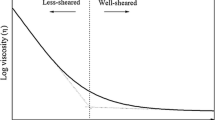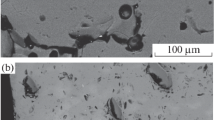Abstract
The viscosity of a series of six synthetic dacitic liquids, containing up to 5.04 wt% dissolved water, was measured above the glass transition range by parallel-plate viscometry. The temperature of the 1011 Pa s isokom decreases from 1065 K for the anhydrous liquid, to 864 K and 680 K for water contents of 0.97 and 5.04 wt% H2O. Including additional measurements at high temperatures by concentric-cylinder and falling-sphere viscometry, the viscosity (η) can be expressed as a function of temperature and water content w according to: \(\log _{10} {\text{ }}\eta = - 4.43{\text{ }} + {\text{ }}{{\left( {7618.3 - 17.25{\text{ }}\log _{10} {\text{ }}\left[ {w{\text{ }} + {\text{ }}0.26} \right]} \right)} \mathord{\left/ {\vphantom {{\left( {7618.3 - 17.25{\text{ }}\log _{10} {\text{ }}\left[ {w{\text{ }} + {\text{ }}0.26} \right]} \right)} {\left( {T - \left\{ {406.1 - 292.6{\text{ }}\log _{10} {\text{ }}\left[ {w{\text{ }} + {\text{ }}0.26} \right]} \right\}} \right)}}} \right. \kern-\nulldelimiterspace} {\left( {T - \left\{ {406.1 - 292.6{\text{ }}\log _{10} {\text{ }}\left[ {w{\text{ }} + {\text{ }}0.26} \right]} \right\}} \right)}}\) where η is in Pa s, T is temperature in K, and w is in weight percent. Within the conditions of measurement, this parameterization reproduces the 76 viscosity data with a root-mean square deviation (RMSD) of 0.16 log units in viscosity, or 7.8 K in temperature. The measurements show that water decreases the viscosity of the dacitic liquids more than for andesitic liquids, but less than for rhyolites. At low temperatures and high water contents, andesitic liquids are more viscous than the dacitic liquids, which are in turn more viscous than rhyolitic liquids, reversing the trend seen for high temperatures and low water contents. This suggests that the relative viscosity of different melts depends on temperature and water content as much as on bulk melt composition and structure. At magmatic temperatures, rhyolites are orders of magnitude more viscous than dacites, which are slightly more viscous than andesites. During degassing, all three liquids undergo a rapid viscosity increase at low water contents, and both dacitic and andesitic liquids will degas more efficiently than rhyolitic liquids. During cooling and differentiation, changing melt chemistry, decreasing temperature and increasing crystal content all lead to increases in the viscosity of magma (melt plus crystals). Under closed system conditions, where melt water content can increase during crystallization, viscosity increases may be small. Conversely, viscosity increases are very abrupt during ascent and degassing-induced crystallization.









Similar content being viewed by others
References
Alidibirov M, Dingwell DB, Stevenson RJ, Hess KU, Webb SL, Zinke J (1997) Physical properties of the 1980 Mount St. Helens cryptodome magma. Bull Volcanol 59:103–111
Avard G, Whittington A, Rose W, Matias O, Cornejo J (2006) Domes and flows: do temporal trends in dacitic magma chemistry and rheological behavior at Santiaguito, Guatemala, reflect magma chamber or conduit processes? EOS Trans AGU 87(52) Fall Meet Suppl, Abstract V51E-1718
Bachmann O, Bergantz GW (2004) On the origin of crystal-poor rhyolites extracted from batholithic crystal mushes. J Petrol 45:1565–1582
Behrens H, Romano C, Nowak M, Holtz F, Dingwell DB (1996) Near-infrared spectroscopic determination of water species in glasses of the system MAlSi3O8 (M = Li, Na, K): an interlaboratory study. Chem Geol 128:41–63
Caricchi L, Burlini L, Ulmer P, Gerya T, Vassalli M, Papale P (2007) Non-Newtonian rheology of crystal-bearing magmas and implications for magma ascent dynamics. Earth Planet Sci Lett 264:402–419
Castro JM, Mercer C (2004) Microlite textures and volatile contents of obsidian from the Inyo volcanic chain, California. Geophys Res Lett 31:L18605 4pp. DOI 10.1029/2004GL020489
Costa A (2005) Viscosity of high crystal content melts: dependence on solid fraction. Geophys Res Lett 32:L22308 5pp. DOI 10.1029/2005GL024303
Dingwell DB, Romano C, Hess K-U (1996) The effect of water on the viscosity of a haplogranitic melt under P-T-X conditions relevant to silicic volcanism. Contrib Mineral Petrol 124:19–28
Eichelberger JC, Izbekov PE, Browne BL (2006) Bulk chemical trends at arc volcanoes are not liquid lines of descent. Lithos 87:135–154
Faxen H (1923) Die Bewegung einer starren Kugel längs der Achse eines nit zäher Flüssigkeit gefüllten Rohres. Arkiv för Mathematik, Astronomi och Fysik 17(27):1–28
Gardner JE, Carey S, Sigurdsson H, Rutherford MJ (1995) Influence of magma composition on the eruptive activity of Mount St. Helens, Washington. Geology 23:523–526
Getson JM, Whittington AG (2007) Liquid and magma viscosity in the anorthite–forsterite–diopside–quartz system, and implications for the viscosity–temperature paths of cooling magmas. J Geophys Res 112:B10203. DOI 10.1029/2006JB004812
Giordano D, Dingwell DB (2003) Non-Arrhenian multicomponent melt viscosity: a model. Earth Planet Sci Lett 208:337–349
Giordano D, Nichols ARL, Dingwell DB (2005) Glass transition temperatures of natural hydrous melts; a relationship with shear viscosity and implications for the welding process. J Volcanol Geotherm Res 142:105–118
Hamilton DL, Burnham CW, Osborn EF (1964) The solubility of water and effects of oxygen fugacity and water content on crystallization in mafic magmas. J Petrol 5:21–39
Hammer JE, Cashman KV, Hoblitt RP, Newman S (1999) Degassing and microlite crystallization during pre-climactic events of the 1991 eruption of Mt. Pinatubo, Philippines. Bull Volcanol 60:355–380
Hammer JE, Rutherford MJ (2002) An experimental study of the kinetics of decompression-induced crystallization in silicic melt. J Geophys Res 107:2021 24pp. DOI 10.1029/2001JB000281
Hess K-U, Dingwell DB (1996) Viscosities of hydrous leucogranitic melts: a non-Arrhenian model. Am Mineral 81:1297–1300
Hess K-U, Cordonnier B, Lavallé Y, Dingwell DB (2007) High-load, high-temperature deformation apparatus for synthetic and natural silicate melts. Rev Sci Instrum 78:075102
Hui H, Zhang Y (2007) Toward a general viscosity equation for natural anhydrous and hydrous silicate melts. Geochim Cosmochim Acta 71:403–416
Lavallée Y, Hess K-U, Cordonnier B, Dingwell DB (2007) Non-Newtonian rheological law for highly crystalline dome lavas. Geology 35:843–846
Leschik M, Heide G, Frischat GH, Behrens H, Wiedenbeck M, Wagner N, Heide K, Geißler H, Reinholz U (2004) Determination of H2O and D2O contents in rhyolitic glasses using KFT, NRA, EGA, IR spectroscopy, and SIMS. Phys Chem Glasses 45:238–251
Liebske C, Behrens H, Holtz F, Lange RA (2003) The influence of pressure and composition on the viscosity of andesitic melts. Geochim Cosmochim Acta 67:473–485
Liu Y, Zhang Y, Behrens H (2005) Solubility of H2O in rhyolitic melts at low pressures and a new empirical model for mixed H2O–CO2 solubility in rhyolitic melts. J Volcanol Geotherm Res 143:219–235
Mandeville CW, Webster JD, Rutherford MJ, Taylor BE, Timbal A, Faure K (2002) Determination of molar absorptivities for infrared absorption bands of H2O in andesitic glasses. Am Mineral 87:813–821
Marsh B (1981) On the crystallinity, probability of occurrence and rheology of lava and magma. Contrib Mineral Petrol 78:85–98
Melson WG (1983) Monitoring the 1980–1982 eruptions of Mount St. Helens; compositions and abundances of glass. Science 221:1387–1391
Mysen B, Richet P (2005) Silicate glasses and melts—properties and structure. Elsevier, Amsterdam
Neuville DR, Courtial P, Dingwell DB, Richet P (1993) Thermodynamic and rheological properties of rhyolite and andesite melts. Contrib Mineral Petrol 113:572–581
Ochs FA III, Lange RA (1999) The density of hydrous magmatic liquids. Science 283:1314–1317
Ohlhorst S, Behrens B, Holtz F (2001) Compositional dependence of molar absorptivities of near-infrared OH– and H (sub 2) O bands in rhyolitic to basaltic glasses. Chem Geol 174:5–20
Petford N (2003) Rheology of granitic magmas during ascent and emplacement. Annu Rev Earth Planet Sci 31:399–427
Richet P, Lejeune AM, Holtz F, Roux J (1996) Water and the viscosity of andesite melts. Chem Geol 128:185–197
Richet P, Whittington A, Behrens H, Holtz F, Ohlhorst S, Wilke M (2000) Water and the density of silicate glasses. Contrib Mineral Petrol 138:337–347
Russell JK, Giordano D, Dingwell DB (2003) High-temperature limits on viscosity of non-Arrhenian silicate melts. Am Mineral 88:1390–1394
Scaillet B, Holtz F, Pichavant M, Schmidt M (1996) Viscosity of Himalayan leucogranites: implications for mechanisms of granitic magma ascent. J Geophys Res 101:27691–27699
Scaillet B, Holtz F, Pichavant M (1997) Rheological properties of granitic magmas in their crystallization range. In: Bouchez JL, Hutton DHW, Stephens WE (eds) Granite: from segregation of melt to emplacement fabrics. Kluwer Academic, Dodrecht, pp 1–29
Scaillet B, Whittington A, Martel C, Pichavant M, Holtz F (2000) Phase equilibrium constraints on the viscosity of silicic magmas; II, Implications for mafic-silicic mixing processes. Trans R Soc Edinb 91:61–72
Schulze F, Behrens H, Holtz F, Roux J, Johannes W (1996) The influence of H2O on the viscosity of a haplogranitic melt. Am Mineral 81:1155–1165
Spera FJ (2000) Physical properties of magma. In: Sigurdsson H (ed) Encyclopedia of volcanoes. Academic Press, New York, pp 171–190
Vetere F, Behrens H, Holtz F, Neuville D (2006) Viscosity of andesitic melts—new experimental data and a revised calculation model. Chem Geol 228:233–245
Whittington A, Richet P, Holtz F (2000) Water and the viscosity of hydrous depolymerized aluminosilicate melts. Geochim Cosmochim Acta 64:3725–3736
Whittington A, Richet P, Linard Y, Holtz F (2001) The viscosity of hydrous phonolites and trachytes. Chem Geol 174:209–224
Whittington A, Richet P, Behrens H, Holtz F, Scaillet B (2004) Experimental temperature–X(H2O)–viscosity relationship for leucogranites, and comparison with synthetic silicic liquids. Trans R Soc Edinb 95:59–72
Zhang Y, Xu ZJ, Liu Y (2003) Viscosity of hydrous rhyolitic melts inferred from kinetic experiments, and a new viscosity model. Am Mineral 88:1741–1752
Acknowledgements
This work was supported by NSF grant EAR-0407915 to Alan Whittington. Additional support by the German DFG (grant Be1720/12) is also acknowledged. Jackie Getson is thanked for laboratory assistance.
Author information
Authors and Affiliations
Corresponding author
Additional information
Editorial responsibility: D. Dingwell
Rights and permissions
About this article
Cite this article
Whittington, A.G., Hellwig, B.M., Behrens, H. et al. The viscosity of hydrous dacitic liquids: implications for the rheology of evolving silicic magmas. Bull Volcanol 71, 185–199 (2009). https://doi.org/10.1007/s00445-008-0217-y
Received:
Accepted:
Published:
Issue Date:
DOI: https://doi.org/10.1007/s00445-008-0217-y




